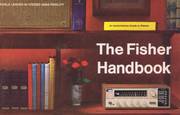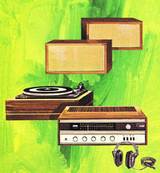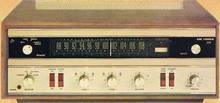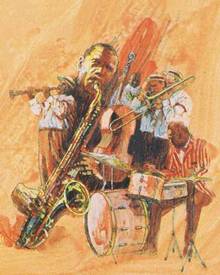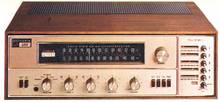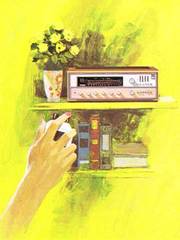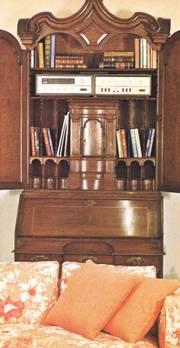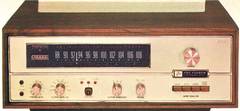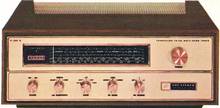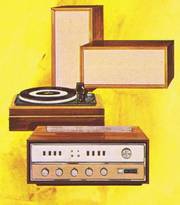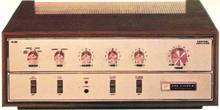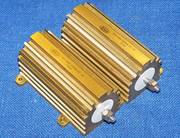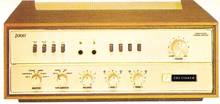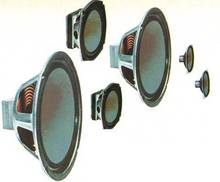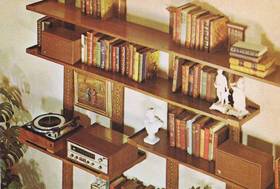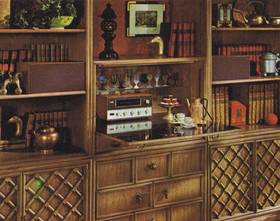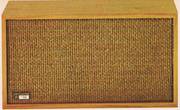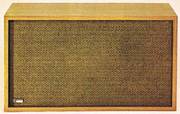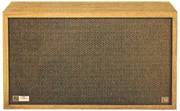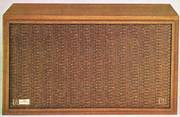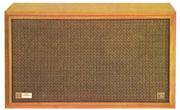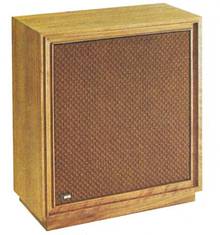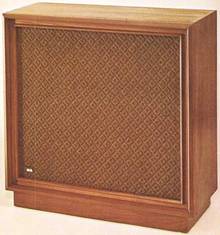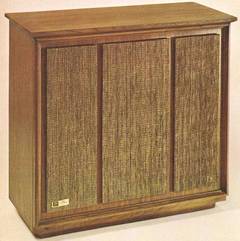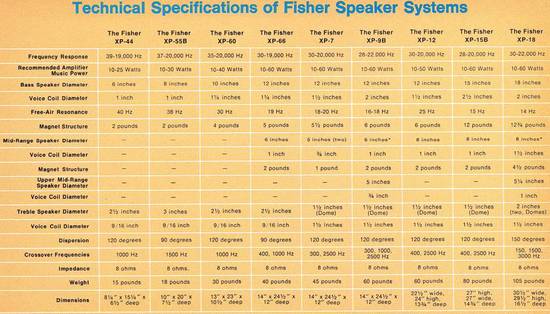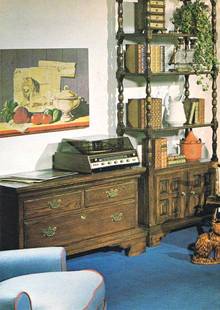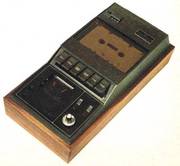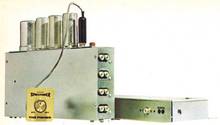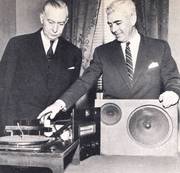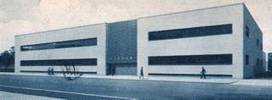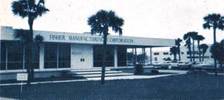Und jetzt zu den Fisher Geräten von 1968
Die Firma "The Fisher" hatte bis zur Übernahme durch SANYO etwa 1975 hervorragende Geräte, die vielleicht den Zug der Zeit verschlafen hatten oder seit ein paar Jahren in Amerika zu teuer produziert worden sind.
Dennoch waren die Geräte von sehr guter Qualität. Sicher waren sie etwas unter dem Level von McIntosh positioniert, doch insgesamt waren es super Konzepte.
Das ist der Teil 2 der 1968er "The Fisher" Broschüre
.
The Stereo Receiver

- The Fisher 160-T is a compact high-powered receiver with exclusive TUNE-O-MATIC® pushbutton memory tuning. This high fidelity system features the Fisher 160-T, DUAL 4-speed automatic turntable, and a Fisher XP-12 Consolette Speaker System. Another Fisher XP-12, not shown, has been strategically placed for optimum stereo separation.
Everything You Need On One Beautifully Integrated Chassis
THE RECEIVER changed stereo high fidelity from an expensive hobby to a popular mass entertainment medium that everyone could enjoy. For those unfamiliar with the term, a receiver is an electronic component that combines all the functions of tuner, amplifier and preamplifier into one, beautifully integrated chassis. For stereo, simply add two speaker systems of your choice.
It was the RECEIVER that made stereo a realistic and worthwhile home entertainment medium. A certain number of bulky components were no longer necessary. They invariably occupied more space than one would have preferred, and inevitably cost somewhat more than one would have cared to invest.
In their place, one, amazingly compact Fisher Receiver was not only able to outperform separate units, but was able to fit any available space. (In very tight quarters, a closet will do, although the design and appearance of the Receiver is so brilliant that its exposure on bookshelf or endtable is almost mandatory.) The newest line of Fisher Receivers are all striking examples of how stereo equipment can beautifully blend with any home decor, regardless of where it is placed.
.
Today, you do not have to be technically inclined to select or install a stereo system. If you let your ears be the judge, you will find it unusually simple to choose the Fisher Receiver and pair of Fisher Speaker Systems that best perform to your personal listening taste.
Fisher receivers are available in moderately priced, deluxe and luxury class models. Each model, regardless of cost, will not sound strikingly different, for each is designed to the same high standard of performance. They differ greatly in all other aspects, such as flexibility of control, power output rating, conveniences, number of input and output connections, physical size, engineering circuitry, and general appearance.
The Fisher 160-T
40-Watt FM-Stereo Receiver
HERE IS the world's first high quality pushbutton FM-Stereo Receiver. You can push-tune any of your five favorite FM stations at the press of a button. You can tune the same five vertical FM dials separately, by hand. You can connect tape recorder and phonograph and be assured of a breadth of flexibility generally associated with professional equipment. You can channel the musical program into any room of the home, or listen through stereo headphones in absolute privacy.
But for all its versatility, the truly unique feature of this instrument is its unusually low price: less than $200.00 including a beautiful cabinet with sculptured walnut sides. ¦ For its modest cost, the remarkable push-tune feature you can enjoy is TUNE-O-MATIC® Memory Tuning. Whatever station you have manually tuned in, Automatic Frequency Control (AFC) locks it within a diode memory bank. Thereafter, whenever you press the button, even after you have tuned in other stations on the dial, the set tunes instantly to the perfect center-of-channel for reception of that originally desired station. No 'off-center' drift. No distortion. In addition, exclusive Stereo Beacon* automatically signals the presence of stereo and automatically switches to the stereo mode and back again. At its unusually low price, there is nothing quite like the Fisher 160-T.
SIZE: 15 1/4" wide, 3 1/2" high, 11 1/4" deep. WEIGHT: 15 pounds.
The Fisher 175-T
65-Watt AM-FM Stereo Receiver
THE FISHER 175-T is a landmark in high fidelity engineering. It is the first high-powered receiver with professional AM and FM-Stereo facilities to be offered at half the cost one would expect to pay. In terms of total performance, the Fisher 175-T is unquestionably the finest value in the AM-FM Receiver category. It has 65 watts of music power at 8 ohms — a measurement that conforms to the impedance of virtually every speaker system of good quality.
It has comprehensive tape and phono facilities, and provisions for an auxiliary source. It has main and remote speaker switches for guiding the musical program to virtually every room of your home. At your option, you can turn off all speakers and listen to your favorite recording or broadcast through headphones which plug into the front panel receptacle. This flexibility, the most significant barometer of an amplifier's capability, is matched to an ingenious tuner section.
The most advanced kind of Field Effect Transistors and Integrated Circuits (IC's), incorporated in the high-sensitivity front-end and IF stages respectively, can seek out the most distant and weakest FM stations one would consider unobtainable. The large, easy-to-read numbers on the AM and FM dial glass is only one of many conveniences that make tuning a pleasure, never a problem.
SIZE: 15 1/2" wide, 4" high, 12 3/4" deep. WEIGHT: 18 pounds. CABINET: Walnut (vinyl) 60-UW, optional at additional cost.
The Fisher 200-T
70-Watt FM-Stereo Receiver
THE FISHER 200-T is a desirable selection for those who have never owned a piece of high fidelity equipment. It is a sensibly priced, fully integrated FM-Stereo receiver with an abundance of power and breadth of flexibility rare in equipment of such modest cost.
Seventy watts of music power, more than enough to drive several pairs of speakers to full room volume, provide a musical treat for virtually every room of your home. By turning the master 4-way speaker selector to its off position, you can turn your speakers off, and enjoy the program in the privacy of headphones.
- Anmerkung: Das mit den 70 Watt Music Power ist natürlich - wie bei uns in Deutschland damals auch -, sehr weit her geholt. Denn übrig blieben von den 35 Watt pro Kanal Musikleistung viel zu oft nicht mal 20 Watt Sinus. Und das nun noch auf mehrere Lautsprecher-Paare im ganzen Haus verteilt, das reicht gerade mal für leichte Bar-Musik.
.
The full complement of logically grouped tone controls and switches, including loudness contour and muting, will shape and amplify sound from tape, records and broadcasts to your precise requirements.
The super-sensitive FM tuner features a Field-Effect-Transistor front end, followed by three Integrated Circuits (IC's) that perform the IF amplification and limiting functions. The d'Arsonval tuning meter and patented Stereo Beacon* automatic mono/stereo switching provide unlimited tuning luxury. The large, illuminated dial glass is, in itself, an easy-to-read convenience. As a proven favorite of thousands, the 200-T is worthy of the discerning audio veteran as well as the newcomer to the stereo hobby.
SIZE: 15 1/2" wide, 4" high, 11 1/2" deep (including control panel and fuse post). WEIGHT: 22 pounds. CABINET: Walnut, 50-UW, optional at additional cost.
.
The Fisher 250-T
100-Watt AM-FM Stereo Receiver
HERE IS a rare, masterful feat of engineering genius - a complete AM and FM Stereo Receiver with unusual flexibility in tuning and audio control, possessing enormous power, a wealth of conveniences, and a standard of performance surpassing anything in its price class. Its exterior, tastefully designed with muted multi-tone metal panels, reveals a full complement of easy-to-use controls and switches, complemented by two separate modes of tuning. The first, TUNE-O-MATIC® Push-Button Memory Tuning, lets you select any five FM stations at the press of a button with perfect center-of-channel accuracy.
Automatic Frequency Control (AFC) electronically locks in the desired FM stations forever, changing only when you unlock AFC by hand. The second method features the flywheel dial used in conventional tuning. The station pointer runs along an extra-wide dial glass in the upper panel for convenient station selection.
The Fisher 250-T's tuner section has all the high-sensitivity, high-selectivity and capacity to handle powerful adjacent signals that one expects from advanced FET technology. Weak and distant stations are now within easy reach. Even if you reside in an area near an FM transmitter, you are assured of perfect reception of that weaker, adjacent station.
With 100 watts of music power at 8 ohms*, this instrument will drive several pairs of the most inefficient speakers to full room volume.
SIZE: 15 1/2" wide, AW high, 12" deep (maximum depth from control panel to rear AM antenna). WEIGHT: 19 pounds. CABINET: Walnut (vinyl), 60-UW, optional at additional cost.
*This rating is the most meaningful, since virtually all speaker systems are designed for use with an 8Ohm amplifier output impedance.
The Fisher 400-T
150-Watt AM-FM Stereo Receiver
HERE IS AN ULTRA-SENSITIVE, super-powered receiver with spectacular convenience and performance features truly representative of Space Age technology.
Its exclusive TUNE-O-MATIC® Pushbutton Memory tuning and more conventional flywheel tuning method are complemented by the convenience of Stereo Beacon* automatic mono/stereo switching and a d'Arsonval tuning meter. * TUNE-O-MATIC® permits you to preset five separate FM dials to your favorite FM Stations and thereafter, instantly select them at the press of a button.
Automatic Frequency Control electronically locks in the desired stations, eliminating the 'off-center' drift that ordinarily occurs in mechanical pushbutton car radios. With 150 watts of music power at 8 ohms, the Fisher 400-T will drive several pairs of speaker systems effortlessly — possibly enough for every room of the home. The breadth of audio controls is equally empressive. Bass and treble controls with Baxandall feedback circuits provide bass without boom, even at the lowest volume settings. Loudness Contour, Muting, Direct Tape Monitor and separate main and remote speaker switches are among the features that permit one to adjust and channel the musical program to suit virtually any acoustic environment. ® For sheer tuning convenience, ease of operation, and total performance, the Fisher 400-T is particularly worthy of the audio connoisseur.
SIZE: 15 1/2" wide, 4" high, 14 1/4" deep (maximum depth from control panel to rear AM antenna).
WEIGHT: 25 pounds. ¦ CABINET: Walnut, (Vinyl) 80-UW, optional at additional cost. *U.S. Patent No. 3290443
The Fisher 800-T
190-Watt AM-FM Stereo Receiver
THE FISHER 800-T is the most notable engineering achievement in the high fidelity industry within the past decade. It has four methods of tuning, including the Fisher RK-30, an AutoScan signal-seeking wire remote control.
In addition to wire remote control and conventional flywheel tuning, the Fisher 800-T features AutoScan Touch Tuning and TUNE-O-MATIC® Pushbutton Memory Tuning. AutoScan electronically scans a tuning dial located directly above the signal-strength meter. At the press of the AutoScan pushbutton, the signal-strength meter converts to a frequency indicator.
.
TUNE-O-MATIC® permits you to preset four separate FM dials to your four favorite FM stations and thereafter, instantly select the desired station at the press of a button.
The impressive array of audio controls and switches are designed for complete use of tape, phono and broadcast facilities. In its design and circuitry, the 800-T reflects the genius of Fisher engineering. A crystal FM-IF filter and dual-gate RF MOSFETs, never before used in the FM tuner of any high fidelity equipment, provide the most sensitive and selective FM reception ever achieved.
A new 4-resonator ceramic ladder-filter greatly improves long distance reception and reduces whistles, static and interference. With 190 watts of music power at 8 ohms, this instrument will drive any number of speaker systems.
SIZE; 5 1/2" high, 16 1/2" wide, 14 1/2" deep (maximum depth from control panel to rear AM antenna). WEIGHT: 30 pounds. CABINET: Walnut (Vinyl) 90-UW, optional at additional cost.
The Stereo Tuner
High-Sensitivity and High-Selectivity Are the Key Barometers
SINCE the advent of high fidelity, Fisher tuners have been recognized as the finest in the world. They can be found in hundreds of American and foreign broadcast stations, including the world-renowned Royal Telecommunications FM Network of Sweden. Although selection of a TUNER is based on many factors, the two prime barometers of the instrument's capability is its sensitivity and selectivity.
The first is the measure of a tuner's capacity to sense the presence of weak signals from the broadcast station, and to convert such signals to enjoyable and useful dimensions measured in many times their original power. This capacity is measured in microvolts (millionths of a volt). The lower the figure, the finer the tuner. The second, selectivity, represents the capacity of the tuner to receive the station it has selected without any interference from other stations. Selectivity is measured in decibels; the higher the number, the better the tuner. All Fisher tuners have an extreme degree of sensitivity and selectivity.
The Fisher R-200-B is the world's first high fidelity tuner that offers facilities for the reception of regular AM broadcasts, shortwave stations, and weather and navigation longwave in addition to matchless FM reception. The crowning gem of all Fisher tuners is the Fisher TFM-1000. There is no other like it in all the world for it incorporates seven exclusive circuits that will set the standard of performance for years to come.
Fisher Tuners can be found in hundreds of American and foreign broadcast stations. Your favorite FM station probably monitors its broadcasts with a Fisher.
The Fisher TFM-1000
Laboratory-Standard, All-Transistor FM-Stereo Tuner
THE TFM-1000 is the first FM-Stereo tuner with absolutely perfect facilities for receiving FM broadcasts. It is in every way the ultimate tuner. It has no traceable distortion. It will not overload. It represents a giant stride beyond all previous conceptions as to what an FM tuner should be able to do.
The SUPER SYNCHRODE front-end uses silicon field effect transistors (FET's) for suppression of spurious response and high overload capability. The double-shielded front-end has two RF stages, a four-gang variable capacitor, and six tuned circuits.
A unique Overload Suppressor Circuit automatically holds the signal strength of the FM signal within a range that can be easily handled. The result is to give the TFM-1000 a dynamic range superior to that of any FM tuner ever produced.
The most revolutionary feature of this instrument is the Counter Detector Demodulator with Symmetrical Hard Limiters. It completely eliminates distortion and achieves the remarkably low capture ratio, never attained, of 0.6 db. It has no tuned circuits and is therefore not subject to drift.
The push-button-operated Clear Signal Indicator shows the relative purity of received FM signals. It is an invaluable tool for orienting rotatable antennas. A Power Amplifier Circuit has sufficient audio power for high quality, low-impedance headphones. Either low or high-impedance headphones can be plugged into the front panel for use with a separate volume control.
DIMENSIONS: 16" wide, 5 1/8" high, 12" deep (maximum depth from control knobs to rear fuse post). WEIGHT: 18 pounds. CABINET: Walnut, Model 100-UW, optional at additional cost.
THE SHORT WAVE BAND
By ROLAND GELATT, Associate Publisher, High Fidelity
THE SHORT WAVE BAND is beginning to appear on high fidelity tuners - and that's I a pretty weird thing, because nothing could be further from the sound of high fidelity than a short wave broadcast. What you're apt to encounter here is so fascinatingly different from domestic AM or FM that you'll willingly settle for lower sonic quality.
For Stateside listeners the most consistently enjoyable fare comes from London. The BBC World Service broadcasts almost around the clock on several different wavelengths; and although it comes in strongest during the late afternoon and evening, when transmissions are beamed directly to North America, you can usually pick up the World Service at any time.
Radio Moscow short waves its "second network" program (known as "Mayak"), which comes in strong on the East coast of North America from mid-morning until late afternoon. "Mayak" is a light program with news on the hour and commentary or interviews on the half-hour, interspersed with music.
Other opportunities for eavesdropping on domestic programs are offered by the ORTF in Paris, which relays on short wave a few hours of France-Inter — another news-and-music affair, good for desultory listening and brushing up your French; by Norsk Rikskringkasting, which broadcasts an hour and a half of the home service for the benefit of nostalgic Norwegians abroad; and by the Swiss Broadcasting Corporation, whose 250-kilowatt transmitters at Schwarzenburg relay portions of the home programs in German, French, and Italian.
Australia and China (Peking variety) have extensive wave schedules; plenty of Latin American cha-cha and rhumbas emanate from transmitters south of the border; and there are some English-language evangelical stations in such unlikely places as Ecuador and Bonaire (in the Netherlands Antilles).
Finally, a word about equipment. As mentioned at the outset, the short wave band is now showing up on a few component tuners and receivers. The advantages of having short wave incorporated in well-styled components are obvious. And even if the fidelity is low, there's high delight in having the world at your fingertips.
The Fisher R-200-B
Solid-State FM-Stereo, AM, Shortwave Tuner
HEREVER YOU GO, wherever you are, the Fisher R-200-B will keep you in touch with the news and music of the world. A newscast from London, a concert from Paris, a weather report for Singapore — all the cities of the globe can be tuned in with miraculous presence with this remarkable FM-Stereo, AM and Short Wave tuner.
The instrument has five frequency bands for the reception of FM-Stereo, standard AM, weather and navigation, 41-meter to 19-meter short wave, and a 49-meter short wave bandspread scale. Its high-sensitivity FM section features a new version of the Fisher Golden Synchrode front end for high overload rejection. Stereo Beacon, a Fisher trademark and patent, offers automatic mono/stereo switching.
Highest selectivity is maintained by using a tuned AM-RF stage and a three-gang AM tuning capacitor. The Automatic Gain Control (AGC) smooths out variations in signal strength.
The large AM ferrite antenna has a static shield to make it virtually insensitive to man-made, electrical interference. An external wire antenna is included for long distance reception of all AM bands, especially shortwave.
The Fisher R-200-B has facilities for optimum performance both in the United States and abroad. A multi-tap transformer permits operation of the tuner on 50 to 60 Hz power lines from 100 to 135 volts, and 200 to 250 volts.
DIMENSIONS: 15 1/8" wide, 4" high, 14" deep (depth from control knobs to rear antenna in extended position). WT: 181/2 pounds. CABINET: Walnut, 50 UW, optional at additional cost.
The Stereo Control Amplifier
High Power and Flexible Audio Controls
HIGH POWER and flexible audio controls are now on one integrated chassis. The master control amplifier is the nerve center of any high quality stereo system. Its function is twofold: to amplify the signal to the desired audible level, and to control the texture of sound to suit room acoustics, or personal listening tastes. Amplification and audio control were once performed by two separate components, but rapid engineering strides have made it possible to join both units on one integrated chassis while improving the standard of performance.
Among the features one should seek in a master control amplifier are conveniences that enhance the usefulness of a separate amplifier component. The capacity to monitor a tape recording, followed by instantaneous playback with full use of all audio controls, is a desirable feature. A front-panel headphone jack to permit one to enjoy the musical program in complete privacy without disturbing others in the same room is virtually essential. Even ordinary controls such as bass and treble should be designed with a Baxandall circuit to permit perfect sound reproduction of the extreme high and low ends of the audible spectrum. Fisher control amplifiers cover a wide range of reserve power, control flexibility, and convenience features.
At the outset, a fine stereo system may comprise a control amplifier, pair of speaker systems, and record changer or turntable — a combination obtainable at surprisingly modest cost. At a later date, one can add a high-quality tuner, or tape recorder or both, and thus enjoy unlimited freedom in selecting original program material. In general, it is wiser to build gradually, with components of higher quality, than quickly with components of lesser quality. Good equipment can be expected to last twenty-five years, making the difference in cost between ordinary and superb equipment relatively small.
The Fisher TX-100
65-Watt Solid-State Stereo Control Amplifier
THE FISHER TX-100 is the first high-quality, all-transistor control amplifier available at a budget price. This reliable instrument provides more pure undistorted watts per dollar than any other instrument on the market today. Its total output — 65 watts of music power (IHF) — is more than enough to drive additional speaker systems in other rooms of the home. Its flexibility of controls rivals many professional-quality units.
These include a four-position Program Selector (Tape Head, Phono, Tuner, Aux) and a two-position Mode selector (Mono/Stereo), as well as matched volume, balance, bass, and treble controls.
The front panel headphone jack, coupled with the use of a main/remote speaker switch, permits one to enjoy music in other rooms of the home, or in private, without disturbing others in the same room. The Loudness Contour switch automatically increases volume of the very low bass and treble tones to an audible level, thus recreating proper tonal balance at low volume. The exclusive Fisher Direct Tape Monitor permits one to monitor a tape recording with the use of all controls and switches, without changing cable connections.
Rear panel convenience facilities include Tape Head, Phono, Tuner and Aux inputs. The Phono inputs have a slide switch for selecting low or high level cartridges. All in all, the Fisher TX-100 is a prize performer that compares favorably to the more expensive instruments of professional calibre.
DIMENSIONS: 15 1/8" wide, 4" high, 12" deep (maximum depth from control knobs to fuse post). WEIGHT: 17 pounds. CABINET: Walnut, Model 50-UW, optional at additional cost.
How to Judge Amplifier Power in Watts
By Richard Ekstract
Publisher, Audio Times
THESE are days of POWER - great surging amplifier power that promises to unleash pure, undistorted sound from as many speakers as you are capable of connecting and placing in your home. Unfortunately, your 100-watt stereo amplifier may not have any more useable power than my five-year-old 40-watt power amp. Indeed my music may be louder than yours.
The reason for this apparent contradiction is that amplifier ratings, measured in watts, are as variable as the standards that manufacturers use in their published specifications. An amplifier with 80 watts of peak music power may have only 40 watts of music power. The same 40 watts may have earned its rating at 4 ohms — which has little meaning because most speaker systems are rated at 8 ohms. Furthermore, even if we were to assume your amplifier is actually rated at 80 watts of music power at 8 ohms, this type of power may still not be based on the conservative, "legitimate" power rating standard used by responsible component high fidelity manufacturers.
Music power is rated in two ways. Using the standards established by the Institute of High Fidelity (IHF), members publish specifications on power output at a maximum of 1% total harmonic distortion (THD). In contrast, the Electronic Industries Association (EIA) permits its members to use power ratings with a total harmonic distortion as high as 5%. Although the difference between 1% and 5% distortion may seem slight, it represents a considerable difference in the actual power ratings, as well as in the sound level that will reach your ears.
How should I judge power ratings?
All of which brings us to a perennial question: "How should I judge power ratings?" Unless you are an engineer or a technically inclined enthusiast, it would be best to observe the basic rules.
First, you should be certain the power rating of your amplifier is measured in terms of music power, not peak power or peak music power. Peak power simply refers to the power figured on the instantaneous, momentary peaks of the reproduced sound. It is not directly related to music power, which is the average power developed as sound waves swing from negative to positive and back.
Second, it is of major importance to know if the rating of your amplifier is at 8 ohms, or at 4 or 16. Inasmuch as most speakers are designed for use with an 8-ohm amplifier output impedance, your amplifier rating should be based on that figure. If it is not, we suggest you obtain this specification before you buy. The difference in impedance can make a considerable difference in the power ratings and, naturally, in the acoustical sound level available from your amplifier-speaker combination.
Third, be certain that the power is rated at a total harmonic distortion (THD) of 1% or less. Virtually every quality manufacturer of stereo equipment complies with this standard.
Finally, there is the obvious but forgotten fact that, in stereo, we deal with two channels. For this reason, make certain that you know if the power rating of your amplifier is for one, or for both channels combined.
The only way to make the right amplifier selection is to know and to understand the standards behind these specifications. Unless you do, you may very likely pay slightly more and receive something slightly less in quality than you bargained for.
The Fisher TX-1000
120-Watt Stereo Master Control Amplifier
FOR THOSE who seek an exemplary instrument in audio power and control, Fisher presents the TX-1000 — a 120-watt control-amplifier with the most sophisticated and reliable circuitry ever conceived for use in a high fidelity component. It has more power, more audio control and more pure performance than any other component at any cost, and is winning the accolades of all audio connoisseurs.
It features push button controls for speaker selection, filters and loudness contour. Its plug-in jacks for tape and phones, located on the upper insert of a magnificent gold-plated front panel, add an extra measure of convenience. With the headphone jack, one can enjoy the musical program in privacy, without disturbing others in the room. The six-position program selector permits a choice of microphone, tape, phono, tuner, and includes inputs for amplification of the audio portion of two auxiliary program sources, (i.e. telecast, movie, etc.)
The separate Tape Monitor selector features Left and Right positions to facilitate playback of each of the four tracks of a monophonic tape through both loudspeakers simultaneously. Its Direct Tape Monitor feature permits one to instantly check the quality of the material being taped and make adjustments without changing cable connections. The center channel output is a feature to enable one to drive a "third" or mono remote speaker system — ideal for those who require an added measure of flexibility.
15 1/8" wide, 4" high, 12 3/4" deep (maximum depth from control panel to rear fuse post). WEIGHT 24 pounds. Walnut, Model 50-UW, optional at additional cost.
The Speaker System
High-Efficiency, High-Compliance Sound Repro- ducers - SINCE their introduction nearly 10 years ago, Fisher Speaker Systems have become widely recognized as the finest selection of sound reproducing equipment designed for home use. Today it is not only possible to own a complete Fisher component stereo system, but highly desirable as well. In the past, the potentially exceptional performance of Fisher electronic components had been limited by the quality of the sound transmitted through loudspeakers. No longer is this true.
Fisher speaker systems have been designed and manufactured to the same high standards of Fisher Receivers, Tuners and Amplifiers. Each bass and mid-range loudspeaker is of free-piston design, the most desirable type for perfect sound reproduction. Each speaker system has been acoustically matched to the amplifier driver stages of Fisher components. As a result, they provide the highest degree of efficiency and compliance — the two most important criteria in evaluating speakers objectively. Efficiency determines the amount of electrical power required to produce a given amount of acoustic power.
Compliance is the degree of freedom exhibited by the speaker cone for precise reproduction of the audible spectrum. All Fisher speaker systems, regardless of size of cost, have a natural sounding, resonance-free character that represents the finest in Fisher engineering.
One of the most significant advancements in loudspeaker design in recent years was the development of the small, compact speaker system as a high-quality stereo component. Although these new diminuitive speaker systems are no larger than a shoebox, they have an effortless, natural-sounding quality. In these two attractive stereo installations the pair of Fisher XP-44 Speaker Systems occupy little space, yet will outperform many speaker systems that are far larger and more costly. Each Little Giant features a 6" bass speaker and 2 1/2" treble speaker. The attractive woven grille blends beautifully with any home decor.
The Fisher XP-44
LITTLE GIANT® Free-Piston Speaker System
THE NEW FISHER XP-44 is the smallest and least expensive speaker system in the Fisher line. A pair of '44's' can fit into any area, for they occupy a space no larger than that afforded a few books. Its cost is surprisingly low: less than $90 for a pair. Yet in spite of size and cost limitations, the XP-44 has a completely natural and effortless sound quality. Its bass is round and solid, very close to that of large speakers and at the same time free of artificial correctives. Free air resonance of its 6-inch bass driver is 40 Hz, unusually low for a speaker of such small size.
The upper and extreme high frequencies above 1000 Hz are reproduced by a 21/2-inch speaker. Designed to disperse sound evenly at all planes, the low mass speaker has a marked capacity to sustain ultra high frequencies without coloration or 'break-up.'
The XP-44 has a rich walnut vinyl finish with matching interwoven tweed-like grille cloth. It is the ideal second speaker for the professional or sophisticated music enthusiast in other rooms of the home. And for those with limited space, or newcomers with a limited budget, it is the ideal first speaker.
FREQUENCY RESPONSE: 39 to 19,000 Hz. IMPEDANCE: 8 ohms. SIZE: 8 1/4" x 15 1/4" x 6 1/2" deep. WEIGHT: 15 pounds (each). Can be used horizontally or vertically.
Compact Free-Piston Speaker System
The Fisher XP-55B
THE FISHER XP-55B is a perfect example of how it is possible to attain fine sound throughout the audible spectrum with an acoustic suspension speaker. This system is significantly better than any speaker of comparable size, delivering the full range of the audible spectrum without a trace of distortion, s The massive 8-inch bass speaker incorporates a two-pound magnet structure and totally new suspension system that achieves extra-wide excursion.
The three-inch treble speaker reproduces frequencies from 1500 Hz to beyond audibility. It features a new low-mass cone made of a combination of special fibrous materials. This results in peak-free response out to 20,000 Hz without coloration. Never before has a speaker of such modest size — only 10" x 20" x 7 1/2" deep — been capable of performing to the high-compliance and high-efficiency standards of a professional quality enclosure. For those who seek Fisher quality at a relatively minimal cost, the XP-55B warrants serious consideration, and may well be a rare value that affords the music lover years of listening pleasure.
FREQUENCY RESPONSE: 37 to 20,000 Hz. IMPEDANCE: 8 ohms. 10" x 20" x 7 1/2" deep.
HT: 18 pounds. CABINET: Walnut (vinyl). Can be used horizontally or vertically.
The Fisher XP-60
Two-Way Bookshelf Speaker System
EXTREME CLARITY, precise transients, full and rich texture — these are among a wealth of performance features of the Fisher XP-60. Within severe space and cost limitations, Fisher engineers have created an instrument with all the fundamentals required for high-quality sound reproduction.
The XP-60 features a massive ten-inch free-piston bass speaker. This driver utilizes a four-pound magnet structure, an extremely compliant cone surround, and a 1 1/4"-diameter voice coil. The sub-components give the woofer a free-air resonance of 30 Hz without doubling, and afford astonishing purity and distortion-free response up to 1000 Hz.
The 2 1/2" mid-range/treble speaker has a low-mass cone and high internal damping. These factors, as well as its unique physical shape, give this speaker extremely wide dispersion characteristics. As a result, even the highest audible tones are clear and clean, without an undue shrillness or 'cackle' characteristic of ordinary speakers. The Fisher XP-60 is unhesitatingly recommended to the discriminating music devotee.
FREQUENCY RESPONSE: 35 to 20,000 Hz. IMPEDANCE: 8 ohms. SIZE: 13" x 23" x 10 1/2" deep. WEIGHT: 30 pounds. CABINET: Walnut. Can be used vertically or horizontally.
The Fisher XP-66
Free-Piston Three-Way Speaker System
A THREE-WAY SPEAKER SYSTEM of bookshelf size has been designed by Fisher Laboratories for those who prefer high quality at moderate cost. Its smooth, balanced sound can be attributed to the use of premium-grade transducers and a laboratory-matched crossover network.
The 12" high-compliance free-piston bass speaker handles frequencies down to 30 Hz without distortion or doubling. Transient response of the lower frequencies is assured by the use of a 5-pound magnet structure and butyl-impregnated half-roll surround.
The mid-range portion of the audio spectrum is reproduced by a 6" speaker which is sealed off from other elements of the system by a sub-enclosure. This prevents acoustic interaction between mid-range and woofer.
Because of its low-mass cone, the treble speaker achieves excellent transient response up to the limits of audibility. Frequency separation at 400 and 1,000 Hz is controlled by a low loss 12 db per-octave inductive-capacitive crossover network. The tightly-sealed enclosure is constructed from heavily-braced sheets of dense, non-resonant material with bonded walnut veneers.
FREQUENCY RESPONSE: 30 to 19,000 Hz. IMPEDANCE: 8 ohms. DIMENSIONS: 14" x 24 1/2" x 12" deep. WEIGHT: 40 pounds. CABINET: Oiled Walnut. Can be used horizontally or vertically.
The Fisher XP-7
Free-Piston Three-Way Speaker System
THE FISHER XP-7 is a three-way speaker system with four loudspeakers: a massively-built 12" bass driver, two identical, linear-matched 5" mid-range speakers, and a 1 1/2" wide-dispersion treble speaker with exclusive soft-cloth, dome-shaped construction. In a comparatively short time since its introduction, the XP-7 has been awarded more top-level ratings from important national consumer magazines than any system of comparable size and cost.
Each of the two mid-range drivers are housed in separate, tightly sealed compartments to prevent interaction among bass and mid-range. This 'speaker-within-a-speaker' design is responsible for a full-bodied, in-phase sound.
The bass speaker has a 5 1/2-pound magnet structure and a voice coil diameter of 1 1/2", all tending to eliminate distortion that might ordinarily occur at high volume levels, or in the reproduction of bass tones of 30 to 40 Hz. A low-loss 12 db-per-octave inductive-capacitive crossover network controls the frequency separation at 300 and 2,500 Hz. ¦ At its modest cost, the Fisher XP-7 is a truly remarkable speaker system, offering life-like sound reproduction of the musical program.
FREQUENCY RESPONSE: 30 to 20,000 Hz. IMPEDANCE: 8 ohms. DIMENSIONS: 14" x 24 1/2" x 12" deep. WEIGHT: 45 pounds. CABINET: Oiled Walnut. Can be used horizontally or vertically.
The Fisher XP-9b
Free-Piston Four-Way Speaker System
THE SIGNIFICANT DIFFERENCE in this loudspeaker system is one which becomes instantly apparent when you hear it. For the first time, a system has been designed to split the full-frequency range into four sections rather than the customary three. The bass speaker, with its compliant cone and heavy magnet structure, concentrates solely on frequencies from 28 to 300 Hz; the 6" lower mid-range reproduces frequencies of 300 to 1,000 Hz; the 5" upper mid-range from 1,000 to 2,500 Hz; and the 1 1/2" soft dome treble speaker reproduces frequencies from 2,500 Hz to beyond audibility.
This four-way crossover network removes all likelihood of distortion or tonal imbalance in the sound reproduction of the original program. Audible response is amazingly uniform and natural—crystal clear in the highs, smooth and transparent in the mid-frequencies, clean, tight and solid in the lows. Each speaker in the system is isolated, to avoid interaction between bass and mid-range units. The three-position treble balance control, located at the rear of the speaker system, allows you to adapt the texture of the upper frequencies to the acoustics of the room.
The elaborate all-electrical crossover design has precisely wound coils and capacitors to filter out those frequencies that are above or below a particular driver's operational limit without losses.
FREQUENCY RESPONSE: 28 to 22,000 Hz. IMPEDANCE: 8 ohms. DIMENSIONS: 14" x 24 1/2" x 12" deep. WEIGHT: 60 pounds. CABINET: Oiled Walnut. Can be used horizontally or vertically.
The Fisher XP-12
Consolette Three-Way Speaker System
WHEN USED with an amplifier of good quality, the XP-12 achieves the kind of unbelievable realism that has yet to be equaled. The tone is completely transparent, and one is immediately struck by the quality of 'presence' — a steady, uncolored, and full flow of sound that is clear, precise and unwavering.
Three acoustically matched transducers have been incorporated in this floor model. The 12" bass speaker has a six-pound magnet structure. Its extremely compliant surround is combined with a specially prepared cone material to afford wide excursion and smooth, resonance-free response. The system has a low bass-to-mid-range crossover of 400 Hz, thus permitting the bass speaker to operate at peak efficiency in the lower three octaves of the audible spectrum.
The 8" mid-range speaker has been specially designed for this consolette speaker system. It reproduces frequencies between 400 and 2500 Hz with flawless fidelity. The treble speaker is a wide-dispersion 1 1/2" hemispherical soft dome type, providing pure, uncolored sound to beyond the limits of audibility. By using a soft diaphragm driven on its periphery, high frequency resonances are eliminated. This unique soft dome treble speaker, specially designed for the XP-12, has far less distortion than other transducers that perform the same function. Each of these speaker elements has been tailored to the physical size of the unit to provide a natural sounding, life-like presence that, at its cost, is unsurpassed.
FREQUENCY RESPONSE: 30 to 20,000 Hz. IMPEDANCE: 8 ohms. SIZE: 24" high, 22 1/2" wide, 13" deep. WEIGHT: 60 pounds. CABINET: Walnut.
The Fisher XP-15B
Consolette Three-Way Speaker System
NO LOUDSPEAKER DESIGN has caused as much excitement among high fidelity connoisseurs as the Fisher XP-15. As superb as this instrument was, the new, improved version — XP-15B — goes even further towards achieving absolute perfection. Every hallmark of fine Fisher engineering and design — magnificent styling, precise transient response, exceptionally tight and solid bass — has been featured in this equipment.
The 15" bass speaker features a unique half-roll surround of extreme compliancy as well as a massive 12-pound magnet structure and 2 1/2-inch-diameter voice coil. These conservatively rated materials assure the speaker's capacity to perform perfectly within its assigned frequencies of 28 to 400 Hz.
The 8" mid-range speaker — a size considerably larger than bass drivers in other units — reproduces the frequencies between 400 and 2,500 Hz. ¦ The 1 1/2" hemispherical treble speaker utilizes a soft-dome diaphragm that has excellent dispersion characteristics. Transient response is also unsurpassed because of the unusually high flux density of the tweeter magnet structure and low moving mass of the tweeter diaphragm. The calibrated three-step level control permits one to boost the high frequencies when necessary, or reduce the emphasis on the treble tones to suit room acoustics.
FREQUENCY RESPONSE: 28 to 20,000 Hz. IMPEDANCE: 8 ohms. SIZE: 27" x 27" x 14" deep. WEIGHT: 80 pounds. CABINET: Walnut.
The Fisher XP-18
Consolette Four-Way Speaker System
THE FISHER XP-18 is unquestionably the finest speaker system ever designed for home use. Heart of the speaker complement is a massive 18" bass woofer — the largest high quality loudspeaker ever designed for commercial application. It is capable of handling frequencies down to 14 Hz (2 cycles below the lowest organ tone in the world) and has overwhelming power handling capacity. Its 2" voice coil operates in a 12 1/4-pound magnet structure, providing critical magnetic damping that produces an amazingly solid, non-resonant bass, covering the range from 14 Hz to 150 Hz.
An 8" lower mid-range unit reproduces the frequencies between 150 and 1500 Hz. Like the bass speaker, the lower mid-range unit is sealed in its own sub-enclosure to prevent acoustic interaction with other speakers in the system. Its upper mid-range unit is a smaller, 5 1/4" free-piston speaker in a sealed sub-enclosure. The upper mid-range speaker reproduces frequencies from 1500 to 3000 Hz.
The upper limits of the audible spectrum are handled by two linearly matched 2" treble speakers having a 150° angle of sound distribution (extremely important with directional high frequencies).
Three level controls at the rear of the cabinet permit one to adjust the relative output of the various speakers to conform to the acoustic conditions of the room, as well as the listening tastes of the user.
FREQUENCY RESPONSE: 30 to 22,000 Hz. IMPEDANCE: 8 ohms. SIZE: 30 1/2" wide, 29 1/2" high, 16 1/2" deep. WEIGHT: 105 pounds. CABINET: Oiled Walnut.
The Stereo Mods
By Norman Eisenberg - Audio-Video Editor, High Fidelity
WHETHER you think of "mod" as modern, modular, or even modest, the term aptly defines stereo's newest product form, also known as the three-piece music system. In these installations one cabinet (usually in walnut) houses a record changer and a control amplifier (sometimes with a tuner, making it a stereo receiver) and is known as the electronics module or, less austerely, as the control unit; two matching cabinets house a pair of stereo speakers.
.
(Es sind die Billig-Produkte)
Such systems have also been called "compacts" — a term suggesting a place in the audio world somewhat akin to that enjoyed by compacts in the auto world: not as luxurious or as high-powered or as "last-word" as full-size, but fun to own, economical, and right handy for parking in tight spots. And most important, very competent performers.
The engineering principle behind the stereo mods is component integration: record changer, cartridge, amplifier (or receiver), and speakers are chosen for their ability to work efficiently with each other at a predetermined level of performance commensurate with the system's cost. There is, in other words, a ceiling on the ultimate sonic splendor you can expect of a mod. It is a very high ceiling, but a ceiling nonetheless. And this really is what distinguishes the mod from a system made up of separates.
Directly responsible for this development is the use of transistors. Transistors are, in fact, the star performers here. They have made possible the design of audio equipment small enough, and cool-running enough, to permit its being closely installed in a common enclosure where record player and a full array of electronics share less than two cubic feet of space.
Also playing a major part in the successful design of the modular system is the improved response now possible with small speakers. Although the audio world still pays homage to the big systems or the costliest bookshelf types, there is a new peerage of compact and inexpensive performers.
The best of them are fairly clean-sounding, and audible differences are subtle. As a class, their bass output, while not overwhelming, is nonetheless convincing: they may not be able to re-create the lowest pedal notes with the nth degree of exactitude, but they will permit you to recognize that it is an organ you're listening to and not a muddled version of an orchestral choir.
The bass they provide is the result of their use of heavy magnets, driving small but efficient cones. This design technique has made for clean reproducers that literally can fit on a shelf and that do not require more than the ten to fifteen watts of amplifier power supplied by the electronic module in order to provide clean bass down to about 60 Hz.
The mid-range and highs in these systems generally are handled by an additional speaker designed for fairly wide-angle dispersion and clean tones up to or just beyond about 14 kHz. While all the elusive highs and the sense of ultimate air and space that you might hear from a costlier, more elaborate speaker system may be missing, you will get the best part of the important overtone structure of music — which will certainly let you distinguish easily between, say, the strings and woodwinds in the upper register.
Most important, these systems have a well-balanced output and do not favor one portion of the musical spectrum over any other: they will neither shriek at you nor blast your ears with overheavy thumping bass. And most of them are quite good at handling transients, those short-duration sonic pulses that lend a touch of realism to reproduced music. Over-all, these systems can fill a normal size room with very listenable sound.
Transistors, small speakers — and style. The stereo mods have an immediate easy-to-live-with quality, a quality built-in and ready-made and apparent as soon as you start unpacking the cartons. Aside from their obvious visual appeal, there is the tidy thought-fulness with which everything is arranged and planned; the prefitted cable connectors neatly bundled and ready to be plugged in; the cartridge already fitted correctly in the arm shell; the freedom from guesswork in determining what size or length of wires to use for hookups; the little fillips in some mods, such as the option to select a colored grille cloth, or the inclusion of a stylus brush on the record changer or a unique just-right arrangement of controls and indicators. You get a feeling that someone finally has taken the trouble to make everything as easy as can be for stereo enjoyment but without, as a concomitant, seriously limiting or compromising the performance.
Die folgenden "FM-Stereo Phonograph Music Center" sind keine Hifi Geräte - es sind "Stereo's"
Offensichtlich verlangte der Markt auch nach deutlich billigeren Stereoanlagen (für den Nachwuchs zum Beispiel), den "The Fisher" auch anbieten musste.
The Fisher 120
FM-Stereo Phonograph Music Center
The Fisher 125
AM-FM Stereo Phonograph Music Center
The Fisher 127
Stereo FM-Phono-Cassetten-Recorder Home Music Center
Intererssant ist jedoch das erste Kassettenbandgerät von Fischer:
.
The Fisher RC-70
THE new Fisher RC-70 is a stereo tape cassette recorder that truly complements your high-quality Fisher stereo system. With it you can record as well as play-back, and be assured of unsurpassed stereo performance, maximum flexibility, and greatest reliability. A pair of professional-quality stereo recording microphones is included. With the stereo microphones, you can make 'live' recordings of the voices of friends and family. In addition, the Fisher RC-70 permits you to tape your favorite records, as well as any AM or FM-stereo broadcast. A Walnut base, 12W, is optional at slight additional cost.
OUTSTANDING FEATURES: Complete Record and Playback Facilities, Mono and Stereo - Pushbutton Controls for Play/Record, Pause, Fast Forward, Reverse, Stop/ Eject - Specially selected, narrow gap, high-resolution heads for widest frequency response on record and playback - Separate VU meters for left and right channels - Record interlock - Digital Counter With Pushbutton Reset. SIZE: 5 1/4" wide, 3 1/2" high, 11 3/4" deep. WEIGHT: 5 pounds.
- Anmerkung: Auch da ist von Hifi noch keine Spur.
The Fisher K-10
DYNAMIC SPACEXPANDER
The Fisher K-10 Dynamic Spac-Expander® electronically recreates the reverberation of the concert hall by artificially reflecting sound so that it reaches a listener's ear a fraction of a second later than it normally would. This reflection, or delay, is identical to the way one would hear a concert in an auditorium, and adds a new dimension to listening pleasure, even in the smallest of rooms.
The K-10 works equally well on records, tape and broadcasts. One control regulates the desired degree of reverberation.
Und jetzt kommen Lobeshymnen von "begeisterten" The Fisher "Kunden" - also bitte lächeln Sie mit. Es ist 1968.
Aber wie das in der Werbung nun mal so ist, sind das beileibe nicht alles Kunden. Vielen wurden die "Stereo's" von den Herstellern quasi aufgedrückt, natürlich völlig ohne Hintergedanken, ähnlich wie Herbert von Karajan über viele Jahre die falschen Regalboxen bei sich auf dem Teppich stehen hatte und absolut beratungsresistent auf deren Standplatz beharrte (sagen die nicht verstummenden Stimmen der Zeitzeugen).
.
- "I have just purchased my third Fisher, and it is giving me the same fabulously true reproduction of my phonograph records, and in the reception of high fidelity broadcasts, as do the first two. It is a constant source of enjoyment and relaxation to me." - Isaac Stern Concert Violinist
- "My Fisher is a magnificent addition to our musical home. It is a constant source of pleasure and a superb instrument for the faithful reproduction of recordings and musical broadcasts." - Rise Stevens - Soprano, The Metropolitan - Opera Company
- "The Fisher is, without question, one of the finest instruments I have ever heard anywhere. Its tone is as close to live performance as I believe it is possible to get, and the high fidelity quality is perfect." - Eugene Ormandy - Music Director - The Philadelphia Orchestra Association
- "I was thrilled and fascinated by the life-like reproduction, not only of my own recordings but those of other artists with whom I have sung at the opera. Many subtle shadings and nuances that I had not realized were in the recordings were fully and beautifully expressed." - Victoria de los Angeles - Soprano, The Metropolitan - Opera Company
- "I have fallen under the spell of Fisher. What used to be only an instrument of necessity has become a source of unlimited pleasure." - Gian-Carlo Menotti Composer
.
High Fidelity, Circa 1937.
America's first commercially manufactured high fidelity radio-phonograph system, built by Avery Fisher in 1937, is presented by Mr. Fisher to Dr. Leonard Carmichael, Secretary of the Smithsonian Institution, March 18, 1960. The Institution made this technological milestone part of its permanent collection.
-
High Fidelity Components, Circa 1950.
In the early days of stereo high fidelity, as many as six monophonic components were required to produce musical programs in multiplex (stereo), exclusive of speakers and speaker systems. These Fisher monophonic components, designed and manufactured nearly twenty years ago, are still in perfect working order. They are (left to right) the Fisher 90-X Gold Cascode Tuner, two Fisher 50-C monophonic preamplifiers, a Fisher MPX-100 Multiplex Adaptor, and two Fisher 70-A monophonic Power Amplifiers. Today, all these components have been beautifully integrated into one, compact chassis that are best known as "Receivers." These 'all-in-one' Receivers are virtually identical to separate Fisher components.
Und nocheinmal eine ganz ausführliche Historie, was die Firma Fisher bis 1968 alles so erfunden hatte . . . .
Fisher Firsts
Milestones in the History of High Fidelity Sound Reproduction
- 1937 First high-fidelity sound systems featuring a beam-power amplifier, inverse feedback, acoustic speaker compartments (infinite baffle and bass reflex) and magnetic cartridges.
- 1937 First exclusively high-fidelity TRF tuner, featuring broad-tuning 20-20,000 cycle fidelity.
- 1937 First two-unit high-fidelity system with separate speaker enclosure.
- 1938 First coaxial speaker system.
- 1938 First high-fidelity tuner with amplified AVC.
- 1939 First dynamic range expander.
- 1939 First 3-way speaker in a high-fidelity system.
- 1939 First center-of-channel tuning indicator.
- 1945 First preamplifier-equalizer with selective phonograph equalization.
- 1948 First dynamic range expander with feedback.
- 1949 First FM-AM tuner with variable AFC. 1952 First 50-watt all-triode amplifier.
- 1952 First self-powered master audio control.
- 1953 First self-powered, electronic sharp-cutoff filter system for high-fidelity use.
- 1953 First universal horn-type speaker enclosure for any room location and any speaker.
- 1953 First FM-AM receiver with a cascode front end.
- 1954 First low-cost electronic mixer-fader.
- 1954 First moderately priced professional FM tuner with two meters.
- 1955 First master audio control chassis with five-position mixing facilities. 1955 First peak power indicator in high-fidelity.
- 1955 First correctly equalized, direct tape-head preamplifier with self-powered audio control.
- 1956 First to use power monitor in a home amplifier. 1956 First all-transistor preamplifier-equalizer.
- 1956 First dual dynamic limiters in an FM tuner for home use. 1956 First performance monitor in a high-quality amplifier. 1956 First FM-AM tuner with two meters.
- 1956 First complete graphic response curve indicator for bass and treble.
- 1957 First GOLDEN CASCODE FM tuner.
- 1957 First Micro-Ray tuning indicator.
- 1958 First stereophonic radio-phonograph with magnetic stereo cartridge.
- 1959 First high-quality remote control system.
- 1959 First complete stereophonic FM-AM receiver (FM-AM tuner, audio control, 40-watt amplifier). 1959 First high-compliance plus high-efficiency Free-Piston loudspeaker system.
- 1960 First to use MicroRay for FM tuning and as a recording audio level indicator.
- 1960 Smithsonian Institution, Washington, D. C, receives for its collection America's first commercially manufactured high-fidelity radio-phonograph, made by Avery Fisher in 1937.
- 1960 First reverberation device for use in a high fidelity equipment—the Fisher Dynamic Spacexpander.
- 1960 First stereo tuner with MicroTune.
- 1960 First FM tuner with six IF stages.
- 1960 First FM tuner with five limiters.
- 1960 First front-panel antenna selector switch, 72-300 ohm, Local-Distant positions.
- 1961 First FM-Stereo multiplex adapter with STEREO BEACON and automatic switching, mono to stereo.
- 1961 First complete FM-multiplex stereo receivers.
- 1961 First FM-stereo tuners with STEREO BEACON and STEREO BEAM.
- 1961 First internal switching system to permit immediate tape playback with use of all controls and switches.
- 1961 First loudspeaker system with frameless woofer cone, to eliminate all parasitic resonance.
- 1962 First simplified-operation control-amplifier, with infrequently used controls behind front-panel cover, yet immediately accessible.
- 1962 First loudspeaker with eddy-current-damped voice coil.
- 1962 First bass speaker with combined serrated-aluminum and fiber cone.
- 1962 First FM tuner kit with separate d'Arsonval meter for tuning and separate cathode ray stereo broadcast indicator (STEREO BEAM).
- 1963 First to use 8417 tubes with unique cavity-anode design.
- 1963 First power amplifier to use oscilloscope-type frequency-compensated input circuit.
- 1963 First amplifier kit with STRATA-BALANCE visual dynamic balancing system.
- 1964 First multiplex adapter with'Flywheel synchronization.'Closely approaches theoretical limit of noise rejection, and of all spurious responses.
- 1964 First AFC with strong locking on weak signals, with no pull-in from adjacent strong signals.
- 1964 First FM Stereo Tuner with STEREOSCAN.
- 1964 First peripherally-driven tweeter with cotton, soft dome.
- 1964 First to use TUNE-O-MATIC circuitry in an FM tuner.
- 1966 First F.E.T. front-end design with over 40 db of Automatic Gain Control (more than ten times that of the best prior solid-state techniques.)
- 1966 First FM tuner with Automatic FM Antenna Signal Attenuator.
- 1966 First FM tuner to achieve 0.6 db capture ratio—three times better than the best previous achievement.
- 1966 First FM Tuner to use a 10-megacycle-wide Counter Detector, eliminating all distortions caused by drift or misalignment, for the life of the tuner.
- 1966 First FM Tuner with clear-Signal Indicator.
- 1966 First FM Tuner to incorporate a Power Amplifier Circuit for high-quality, low-impedance headphones.
- 1966 First time-divisiop multiplex circuit to incorporate a Four-Diode Coincidence Circuit.
- 1966 First Receiver to use TRANSIST-O-GARD® Overload Protection.
- 1967 First high fidelity component with multiple pushbutton FM station selection.
- 1967 First to introduce high fidelity equipment with seven integrated circuits (IC's).
- 1967 First loudspeaker system with 18" free-suspension bass speaker.
- 1968 First high quality radio with TUNE-O-MATIC® touch tuning. 1968 First Receiver with electronic AutoScan Touch Tuning
- 1968 First Receiver to incorporate Crystal IF Filter and dual-gate MOSFETs 1968 First Receiver to incorporate 4-Resonator ceramic Ladder Filter
-

